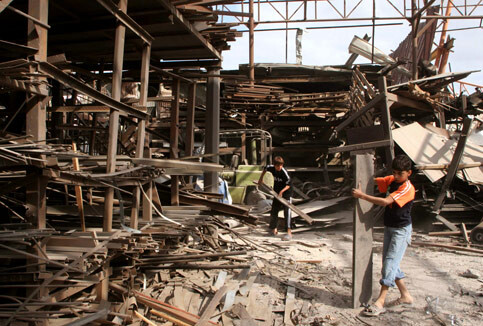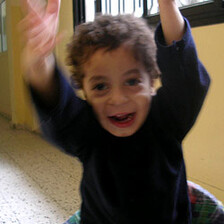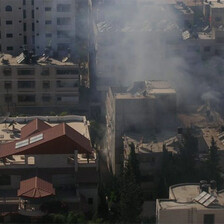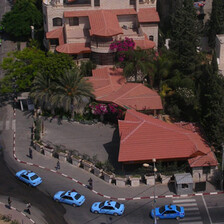Gaza Strip, Palestine 22 May 2007

Palestinians inspect a destroyed metal workshop following an Israeli air strike in Gaza City, early 22 May 2007. (Hatem Omar/MaanImages)
Yesterday eight members of one family were murdered on the spot in Israel’s latest military strike on Gaza. The target, doctor Khaleel Al-Haya, a Hamas member, remained unharmed. Later in the day Islamic Jihad responded by firing two homemade rockets into Gaza. One Israeli citizen was killed, another wounded.
This sounds like a horrible, but straightforward series of events. The only aspect that calls for attention is that one of these attacks is considered terrorism, while the other is mentioned in most media outlets only in passing, and referred to as a legitimate attempt on a bad man’s life. As Israel’s extra-judicial assassinations in Gaza once again become the norm, Gaza is being cast into deeper and deeper despair.
A month ago I visited Sderot and met with Dvora Babyan, an Israeli citizen of Iranian and Libyan descent. A homemade Qassam rocket hit her house on April 21 causing damage to the building but causing no fatalities. Having come from Gaza that morning, I had the sense I was overhearing Dvora’s words as if spoken to a Palestinian living in Gaza.
“We have sense, we are not barbarians. They are barbarians, we want peace but they are not interested … When we strike we have to take into consideration the civilians, they don’t do this,” she said.
Dvora’s mindset entails a particular logic that Israel’s aggression, because a familiar military apparatus is carrying it out, necessarily verifies its legitimacy. It barely matters who is killed or how many bystanders are dead if the intentions are those of a recognized military body. Why? Because behind the decision to carry out one such execution is expected to be a well-thought out and legal procedure, unknown to all and yet accepted by the general public. The targeting of a certain Hamas actor is a foreign scene; a rocket hitting a villa in a nice neighborhood of Sderot on the other hand is too close to home not to become a successful headline that grips reader’s attention.
In her thought process Dvora simply avoids the fact that in this rocket attack on the Gaza Strip eight civilians were killed, including a 16-year-old boy and two men over 60; for since these civilians were killed by the army, they must be legitimate targets. At the least their deaths must have been a worthwhile sacrifice in light of the threat posed by the assassination’s intended target.

A pile of Qassam rockets fired from Gaza to the Israeli town of Sderot, 6 December 2006. (Magnus Johansson/MaanImages)
“Where will I go? This is my country, this is my home, there is no other place.”
Sadly, Dvora would be surprised to know that these questions are not foreign to the Palestinians living only kilometers from her home.
Israeli historian Benny Morris writes this: “the Jewish state would not have come into existence without the uprooting of 700,000 Palestinians. Therefore it was necessary to uproot them … There are circumstances in history that justify ethnic cleansing.” Today Gaza is reaping the consequences of this “necessary” ethnic cleansing. Refugees arriving in Gaza in 1948 must have asked themselves, “Where will I go? This is my country, that was my home, there is no other place.” The home they were referring to lay in the uprooted villages most of which were destroyed shortly after their Palestinian inhabitants were driven from them. No insurance agents came to assess the damages in Palestinian homes that day. No journalists came to write reports. They must have been haunted by that same question, “what barbarian would do this to me?”
The difference between these two cases of questioning is the fact that the coming into existence of Sderot created the hell that the Gaza Strip is today. A little town by the name of Sderot become home to poor immigrants in the early ’50s, only years after it had been cleared of Palestinians living in what was the village of Najd. Another resident of Sderot told me that when he got there in 1989 he thought he was in “the safest place in the world, in the middle of nowhere.” And yet, it was not the middle of nowhere, he had moved onto what was once someone else’s land and adjacent to where that displaced person and their displaced descendents were held imprisoned. There, his displaced neighbors daily faces the consequences of the past. This past is what is allowing for the hell of that very town, Sderot.
“Fear is the hardest thing … People rather go shopping in [the near by town of] Ashqelon than in Sderot because it is safer,” Dvora said.
Gazans have nowhere to escape to.
Today fear fills the hearts of Gaza’s people. A fear that they may one day return from their perpetual search for charity and donation empty handed (80 percent of Gazans are receiving international food aid); a fear of waking to another day of hopelessness (70 percent of Gazans are either unemployed or largely unpaid government employees); a fear that the economic disaster they are experiencing today may overcome their lives (60 percent of the population live under the poverty level of $2 per day); a fear is that this economic crisis will divide the entire population in inter-factional feuding and result in a lawless chaos as factions and political parties vie for the little power that does exist in Gaza.
Over the course of the past week Israel has begun to evacuate Israeli citizens from Sderot and has moved them into a camp in Tel Aviv. Gaza’s only outlet to the world via Egypt has been closed for the past ten days as Gaza’s citizens remains locked in Gaza, like a detention center. When the border opens it is only the lucky few who can “go shopping in Ashqelon.”
Philip Rizk is an Egyptian-German who has lived in Gaza since August 2005 where he works and writes. Philip runs a blog: tabulagaza.com.
Related Links




